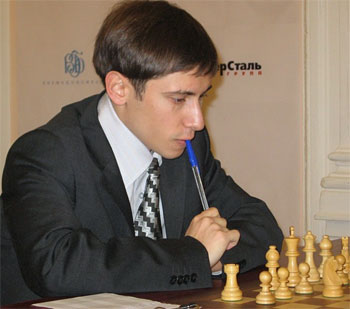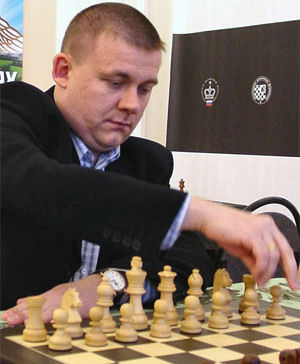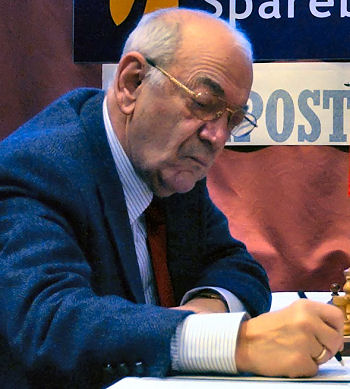| Latest | Greatest | Lobby | Journals | Search | Options | Help | Login |
|
|
|
This topic is archived. |
| Home » Discuss » Topic Forums » Sports |
|
| Jack Rabbit
|
Sun Mar-25-07 04:48 PM Original message |
| The Jack Rabbit Chess Report for March 25 |
|
Edited on Sun Mar-25-07 05:29 PM by Jack Rabbit
The Jack Rabbit Chess Report for the week ending March 25 Contents Post 1: News for the week Post 2: Diagrams and other features Post 3: Games from Current and Recent Events Post 4: Special birthday greeting |
| Printer Friendly | Permalink | | Top |
| Jack Rabbit
|
Sun Mar-25-07 04:49 PM Response to Original message |
| 1. News for the week ending March 25 |
|
Kramnik and Anand lead in Monaco
 Russian grandmaster and World Champion Vladimir Kramnik and Vishy Anand of India lead the Melody Amber Blandfold and Rapid Tournament in Monaco after eight rounds. Kramnik is in full command of the blindfold competition with 7½ points out of eight two points ahead of fellow grandmaster Peter Svidler. Anand, who has been condered the world's premier rapid player for many years, leads that competition with 6½ points out of eight, a full point ahead of Levon Aronian of Armenia. In the overall competition, Kramnik leads Anand with a combined score of 12 out of 16, while Anand has a combined scored of 10½ points. Vassily Ivanchuk of Ukraine also figures in the overall scoring. Unlike many of the players this year, Ivanchuk has done equally well in the Blindfold and Rapid competitions, score 5 points in each for a total of 10 points overall. Ivanchuk is the only one to have played Kramnik in the blindfold competition without losing. Unofficial Cross Table Melody Amber Blindfold & Rapid Tournament Monaco ------- Blindfold ----- 1 2 3 4 5 6 7 8 9 0 1 2 T- (W) --- Rapid ---- 1 2 3 4 5 6 7 8 9 0 1 2 T- (W) - Overall - T- (W) .1 Vladimir Kramnik. . .- * 1 ½ 1 1 1 1 1 * * 1 7½ (7) Anand . . . . .- * 1 * ½ ½ 1 ½ * 1 1 1 6½ (5) Kramnik . .12. (9) .2 Peter Svidler . . . .* - ½ ½ * ½ ½ 1 1 ½ 1 * 5½ (3) Aronian . . . .* - * 1 ½ ½ ½ ½ 1 * 1 ½ 5½ (3) Anand . . .10½ (8) .3 Boris Gelfand . . . .0 ½ - * ½ * 1 * ½ ½ 1 1 5. (3) Ivanchuk. . . .0 * - * 1 * ½ ½ 0 1 1 1 5. (4) Ivanchuk. .10. (6) .4 Vassily Ivanchuk. . .½ ½ * - ½ 1 * ½ * ½ ½ 1 5. (2) Leko. . . . . .* 0 * - 0 ½ 1 1 ½ * ½ 1 4½ (3) Aronian . . 9½ (6) .5 Alexander Morozevich.0 * ½ ½ - 1 1 ½ 1 * * 0 4½ (3) Kramnik . . . .½ ½ 0 1 - * * ½ ½ ½ * 1 4½ (2) Svidler . . 9½ (5) .6 Vishy Anand . . . . .0 ½ * 0 0 - * 1 * ½ 1 1 4. (3) Carlsen . . . .½ ½ 1 ½ * - ½ * ½ ½ ½ * 4½ (1) Morozevich. 8. (4) .7 Levon Aronian . . . .0 ½ 0 * 0 * - * ½ 1 1 1 4. (3) Svidler . . . .0 ½ ½ ½ * ½ - * ½ 1 ½ * 4. (2) Gelfand . . 8. (3) .8 Teimour Radjabov. . .0 0 * ½ ½ 0 * - * ½ 1 1 3½ (2) Morozevich. . .½ ½ ½ 0 ½ * * - ½ 0 * 1 3½ (1) Leko. . . . 7½ (4) .9 Peter Leko. . . . . .0 0 ½ 0 0 * ½ * - ½ 1 ½ 3. (1) Gelfand . . . .* 0 * ½ ½ ½ ½ ½ - * 0 ½ 3. (0) Carlsen . . 7½ (1) 10 Magnus Carlsen. . . .* ½ ½ ½ * ½ 0 ½ ½ - 0 * 3. (0) Rajabov . . . .0 * ½ * ½ ½ 0 1 * - ½ 0 2½ (1) Radjabov. . 7. (3) 11 Paco Vallejo. . . . .* 0 0 ½ * 0 0 0 0 1 - * 1½ (1) Vallejo . . . .* 0 0 ½ * ½ 0 * 1 ½ - * 2½ (1) Vallejo . . 4. (2) 12 Loek van Wely . . . .0 * 0 0 1 0 0 ½ 0 * * - 1½ (1) van Wely. . . .0 ½ 0 0 0 * * 0 ½ 1 * - 2. (1) van Wely. . 3½ (2) The Jack Rabbit Unofficial Cross Table uses games won as first tie break The format of the tournament, perhaps the most prestigious non-rated event in chess today, is for each competitor to play another in a blindfold game in the afternoon and in the evening, against the same opponent with the colors reversed, to play a rapid game. Prizes are awarded for best score in each of the two competitions and for the best overall score. Jakavenko wins Karpov Tournament  Rising Russian star Dmitry Jackavenko comfortably won the 8th Karpov Tournament in the Ural Mountain town of Poikovsky Friday. Jakavenko entered the last round assured of a share of first place, leading his nearest rivals, reinging US champion Alex Onischuk and Modavian grandmaster Viorel Bologan, by a full point. In the last round, he drew with Zhang Piagxiang of China, Bologan drew with Alexey Dreev of Russia and Onishchuk also drew with reigning French champion Vlad Tkachiev Vlad Tkachiev, while reigning Russian champion Evgeny Alekseev won game againt former Russian champion Sergei Rublevsky to finsish in a three way tie for second. Unofficial Cross Table Karpov Tournament Poikovsky, Khanty-Mansi Okrug (Russia) -------------------------- 1 2 3 4 5 6 7 8 9 0 T- (W) .1 Dmitry Jakovenko . . . .- 1 1 ½ ½ ½ 1 ½ ½ ½ 6. (3) .2 Viorel Bologan.. . . . .0 - 0 ½ 1 1 0 ½ 1 1 5. (4) .3 Evgeny Alekseev. . . . .0 1 - ½ 1 0 ½ 1 ½ ½ 5. (3) .4 Alex Onischuk. . . . . .½ ½ ½ - ½ ½ 1 ½ ½ ½ 5. (1) .5 sergei Rublevsky . . . .½ 0 0 ½ - ½ ½ ½ 1 1 4½ (2) .6 Andrei Istratescu. . . .½ 0 1 ½ ½ - ½ ½ ½ ½ 4½ (1) .7 Emil Sutkovsky . . . . .0 1 ½ 0 ½ ½ - ½ ½ ½ 4. (1) .8 Alexey Dreev . . . . . .½ ½ 0 ½ ½ ½ ½ - ½ ½ 4. (0) .9 Vlad Tkachiev. . . . . .½ 0 ½ ½ 0 ½ ½ ½ - ½ 3½ (0) 10 Zhang Pengxiang. . . . .½ 0 ½ ½ 0 ½ ½ ½ ½ - 3½ (0) The Jack Rabbit Unofficial Cross Table uses games won as first tie break Jakovenko finshed with 6 points out of nine, winning three games without a loss. In the seventh round, Jakovenko won his individual game with Alekseev. Alekseev had beat out the higher-rated Jakovenko for the Russian Champion in Moscow in December and for first place in the Aeroflot Open, also in Moscow, in February. Bologan finished second the hard way. He had a bare half-point after four rounds, but then won four games in a row before drawing in the final round to finish with 5 points. Onischuk also fininshed second in a quiet, if somewhat daring way. He one one game and drew eight without a loss. Sargissian runs away at Zafra  Armenian grandmaster Gabriel Sargissian won the Ruy López Memorial Tournament in Zafra, Extremadura (Spain) by crushing the field of seven other grandmasters and international masters. Sargissian scored 6½ points in seven games. The only blemish on his score was a draw against Dutch Grandmaster Ivan Sokolov. Sargissian entered the final round of the tournament Thursday already assured of a clear first place finish, a point and a half ahead of his nearest rival, Peruvian grandmast Julio Granda. Sargissian defeated Grand to finsh 2½ points ahead of second place finishers Granda and Ukrainian grandmaster Ruslan Ponomariov. Unofficial Cross Table Ruy López Memorial Tournament Zafra ------------------------- 1 2 3 4 5 6 7 8 T- (W) 1 Gabriel Sargassian . . .- 1 1 ½ 1 1 1 1 6½ (6) 2 Ruslan Ponomariov. . . .0 - 0 1 1 ½ ½ 1 4. (3) 3 Julio Granda . . . . . .0 1 - 1 ½ ½ ½ ½ 4. (2) 4 Ivan Sokolov . . . . . .½ 0 0 - 0 1 1 1 3½ (3) 5 Manuel Perez Candelario.0 0 ½ 1 - 1 ½ 0 3. (2) 6 Antoaneta Stefanova. . .0 ½ ½ 0 0 - ½ 1 2½ (1) 7 Krishnan Sasikarin . . .0 ½ ½ 0 ½ ½ - ½ 2½ (0) 8 Hou Yifan. . . . . . . .0 0 ½ 0 1 0 ½ - 2. (1) The Jack Rabbit Unofficial Cross Table uses games won as first tie break The Ruy López is named for a Spanish friar, Ruy López de Segura, who was born in Zafra about 1540. Fra López is credited with writing an early treatise on chess and with being one of the best players of his time. In his book, Fra López gave some scant analysis of the opening called on the JRCR the Spanish Royal Game but which in the English speaking world is more commonly called the Ruy López. However, there is no record of Fra López having played the opening, either as White or Black. |
| Printer Friendly | Permalink | | Top |
| Jack Rabbit
|
Sun Mar-25-07 04:50 PM Response to Original message |
| 2. Diagrams and other features of the JR Chess Report |
|
!""""""""# $tMvWlVmT% $OoOoOoOo% $ + + + +% $+ + + + % $ + + + +% $+ + + + % $pPpPpPpP% $RnBqKbNr% /(((((((() White to move This position is a theoretical draw Does this picture make sense to you? If not, or if it looks like a bunch of Wingdings, please click here. Diagrams used in the Jack Rabbit Chess Report are made with Chess Merida, a true type font that is available as freeware at the above link. Also, the JR chess report makes the main variation in annotations more distinct and readable by putting it in red. A secondary variation, is in blue and other colors are used if needed. |
| Printer Friendly | Permalink | | Top |
| Jack Rabbit
|
Sun Mar-25-07 04:51 PM Response to Original message |
| 3. Games from current and recent events |
|
Edited on Sun Mar-25-07 05:28 PM by Jack Rabbit
Chess Games Analysis by JR and Fritz Viorel Bologan - Dmitry Jakovenko, Karpov Tournament, Round 1, Poikovsky Sergei Rublevsky - Vlad Tkachiev, Karpov Tournament, Round 4, Poikovsky Krishnan Sasikiran - Dmitry Jakocenko, Ruy López Memorial Tournament, Round 4, Zafra Hou Yifan - Manuel Pérez Candelario, Ruy López Memorial Tournament, Round 7, Zafra Levon Aronian - Boris Gelfand, Amber Tournament (Rapid), Round 3, Monaco |
| Printer Friendly | Permalink | | Top |
| Jack Rabbit
|
Sun Mar-25-07 04:52 PM Response to Reply #3 |
| 4. Bologan - Jakovenko, Karpov Tournament, Round 1, Poikovsky |
 Dmitry Jakovenko Viorel Bologan vs. Dmitry Jakovenko Karpov Tournament, Round 1 Poikovsky, Khanty-Mansi Okrug (Russia), March 2007 East India Game: Bogo-Indian Defense 1. d4 Nf6 2. c4 e6 3. Nf3 Bb4+ 4. Nbd2
Black: Dmitry Jakovenko !""""""""# $ T +w+l+% $O +v+ V % $ O +oTo+% $M + +oNo% $ + P N P% $P + P + % $ P +q+p+% $+k+r+ +r% /(((((((() White: Viorel Bologan Position after 22. -- Rf8f6 23. Nf3?!
Black: Dmitry Jakovenko !""""""""# $ + +w+ +% $+ + + Vl% $ + +oTn+% $O + No+o% $ +oOv+ +% $Q + O R % $ + + +o+% $K + + + % /(((((((() White: Viorel Bologan Position after 35. b3c4:R 35. -- Rxg6!!
|
| Printer Friendly | Permalink | | Top |
| Jack Rabbit
|
Sun Mar-25-07 04:54 PM Response to Reply #3 |
| 5. Rublevsky - Tkachiev, Kaprov Tournament, Round 4, Poikovsky |
 Sergei Rublevsky Sergei Rublevsky vs. Vlad Tkachiev Karpov Tournament, Roundd 4 Poikovsky, Khanty-Mansi Okrug (Russia), March 2007 Open Royal Game: Neo-Classical Defense (Scotch Opening) 1. e4 e5 2. Nf3 Nc6 3. d4 exd4 4. Nxd4 Bc5 5. Nxc6 Qf6
Black: Vlad Tkachiev !""""""""# $t+v+l+ T% $O O +oO % $ +o+ W M% $+ + + +o% $ V + + P% $+ N OpQ % $pPpB +p+% $+ Kr+b+r% /(((((((() White: Sergei Rublevsky Position after 12. -- e4e3 13. Bxe3!!
Black: Vlad Tkachiev !""""""""# $ T + Tl+% $O Q +oO % $ +o+vV +% $+ + +m+o% $ + + + P% $+ + +p+ % $p+p+ +p+% $+ K Rb+r% /(((((((() White: Sergei Rublevsky Position after 19. -- 0-0 20. Rxe6!
|
| Printer Friendly | Permalink | | Top |
| Jack Rabbit
|
Sun Mar-25-07 04:58 PM Response to Reply #3 |
| 6. Sasikarin - Sargissian, Ruy López Memorial, Round 4, Zfara |
 Gabriel Sargissian Krishnan Sasikiran vs. Gabriel Sargissian Ruy Lopez Festival, Round 4 Zafra, Extremadura (Spain), March 2007 Spanish Grand Royal Game: Sofia Opening 1. e4 e5 2. Nf3 Nc6 3. Bb5 a6 4. Ba4 Nf6 5. 0-0 Be7 6. Re1 b5 7. Bb3 0-0 8. h3
Black: Gabriel Sargissian !""""""""# $t+ TtVl+% $+v+ +oO % $o+ + M O% $MoO + + % $ + Pp+ +% $+p+ +n+p% $ +bN Pp+% $R BqR K % /(((((((() White: Krishnan Sasikiran Position after 16. cd4:p 16. -- d5!?
Black: Gabriel Sargissian !""""""""# $ + TtVl+% $+ + +oO % $ +m+ + O% $+o+wP + % $ + N + +% $+p+rB +p% $ + + Pp+% $R +q+ K % /(((((((() White: Krishnan Sasikiran Position after 25. Nfed4:p 25. -- Nxe5!
|
| Printer Friendly | Permalink | | Top |
| Jack Rabbit
|
Sun Mar-25-07 05:01 PM Response to Reply #3 |
| 8. Hou Yifan- Pérez Candelario, Ruy López Memorial, Round 7, Zfara |
 Hou Yifan Hou Yifan vs. Manuel Pérez Candelario Ruy Lopez Memorial Tournament, Round 7 Zafra, Extremadura (Spain), March 2007 Spanish Grand Royal Game: Chigorin Defense 1. e4 e5 2. Nf3 Nc6 3. Bb5 a6 4. Ba4 Nf6 5. 0-0 Be7 6. Re1 b5 7. Bb3 d6 8. c3 0-0 9. h3 Na5 10. Bc2 c5 11. d4 Qc7 12. Nbd2 cxd4 13. cxd4 Bb7
Black: Manuel Pérez Candelario !""""""""# $ +t+ Tl+% $+vWmV Oo% $o+ O + +% $Mo+pOn+ % $ + +p+ +% $+ +b+n+p% $pP + Pp+% $R BqR K % /(((((((() White: Hou Yifan Position after 18. Ng3f5 18. --Rxf5?!
Black: Manuel Pérez Candelario !""""""""# $ + + +l+% $+w+ V Oo% $o+ O R +% $Mo+ Op+ % $ + + O +% $+ +q+ +p% $pP + Pp+% $R B R + % /(((((((() White: Hou Yifan Position after 25. -- Rf8f6 26. b3!!
|
| Printer Friendly | Permalink | | Top |
| Jack Rabbit
|
Sun Mar-25-07 05:11 PM Response to Reply #3 |
| 9. Aronian - Gelfand, Amber Rapid, Round 3, Monaco |
 Levon Aronian Levon Aronian vs. Boris Gelfand Amber Tournament (Rapid), Round 3 Monaco, March 2007 Semi-Slav Queen's Gambit: Hastings Opening (Anti-Meran Gambit) 1. d4 d5 2. c4 c6 3. Nc3 Nf6 4. Nf3 e6 5. Bg5 h6
Black: Boris Gelfand !""""""""# $t+ +lV +% $Ov+ +o+ % $ +w+o+t+% $+ P B +o% $ Oo+pQm+% $+ N + + % $pP +bPpP% $+ +r+ + % /(((((((() White: Levon Aronian Position after 18. -- Qd7c6 19. Nd5!!
Black: Boris Gelfand !""""""""# $t+ L + +% $O +v+o+ % $ + + +tV% $+ Bp+ +o% $ Ob+ +m+% $+ + + + % $pP + PpP% $+ +rR K % /(((((((() White: Levon Aronian Position after 25. -- Bf5d7 26. h3!
|
| Printer Friendly | Permalink | | Top |
| Jack Rabbit
|
Sun Mar-25-07 04:59 PM Response to Original message |
| 7. Viktor Korchnoi, the grand old man of chess, turned 76 last week |
|
Edited on Sun Mar-25-07 05:22 PM by Jack Rabbit
 Happy birthday to a legend and still the 85th ranked player in the world |
| Printer Friendly | Permalink | | Top |
| DU
AdBot (1000+ posts) |
Mon May 06th 2024, 04:30 AM Response to Original message |
| Advertisements [?] |
| Top |
| Home » Discuss » Topic Forums » Sports |
|
Powered by DCForum+ Version 1.1 Copyright 1997-2002 DCScripts.com
Software has been extensively modified by the DU administrators
Important Notices: By participating on this discussion board, visitors agree to abide by the rules outlined on our Rules page. Messages posted on the Democratic Underground Discussion Forums are the opinions of the individuals who post them, and do not necessarily represent the opinions of Democratic Underground, LLC.
Home | Discussion Forums | Journals | Store | Donate
About DU | Contact Us | Privacy Policy
Got a message for Democratic Underground? Click here to send us a message.
© 2001 - 2011 Democratic Underground, LLC